By Vince Giuliano 9-27 -2023
Preface and a personal note
In April of this year, I experienced a breakthrough in understanding human aging. This was a key event for me, coming after 15 years of full-time study and writing 600 or so articles on nearly every conceivable facet of the subject. A second key breakthrough was directly derived from this understanding. I had finally articulated a simple set of interventions, applicable late in life, that can likely extend healthy active human lifespans by 20% to 30%, allowing most people to be healthy and continuing contributors to their family and professional lives until they are 100 or beyond
To my knowledge I am the only longevity researcher in my age cohort who is still alive, active, researching, writing and publishing. I have been pursuing versions of many of the specific longevity interventions suggested in this blog for over 40 years now, improving on them as I learn more. They seem to continue working well.  Turning 94 in two months(November 17), I am now nearly as heathy, functional, and physically active as I was 40 years ago, and perhaps a bit more professionally engaged and intellectually avtive than ever before, I expect this situation will go on until I am well beyond 100. ”You must have good genes” is not the explanation. Everyone in my family besides my mother died in their 70s. My mother required intensive nursing care starting in her late 80s and died at age 91
Turning 94 in two months(November 17), I am now nearly as heathy, functional, and physically active as I was 40 years ago, and perhaps a bit more professionally engaged and intellectually avtive than ever before, I expect this situation will go on until I am well beyond 100. ”You must have good genes” is not the explanation. Everyone in my family besides my mother died in their 70s. My mother required intensive nursing care starting in her late 80s and died at age 91
What is aging?
Aging is a biological program that proceeds lifelong in phases, from embryogenesis to a final phase whose actions kills everybody left. This is a very ancient program, manifest in the earliest living creatures, and evolutionarily conserved thereafter. Versions of this program operate in every living creature – plants, bacteria, worms, insects, fish, snakes, lizards, and all mammals including us humans. There is a species-determined version of the aging program and corresponding maximum lifespan for every living thing – 123 years for humans.
The final phase of aging turns deadly to kill every living thing off by the absolute age limit for the species – no exceptions. I go on here to characterize the central process of aging, its purpose, what it does, its stages, how it works, and what causes it. Then, I will go on to describe a major hack on aging, one I think is good for average human life extension of 20% to 25%. Far more than the 5% to 12% known for various specific life-extending interventions, like taking rapamycin. I believe this hack can probably postpone the death-sentence action of the aging program by 20-30 years for us humans, and can likely allow most people to remain highly active, healthy and functional until 100 or more. It is the hack that has been working personality for me.
The science of aging is wicked complex and here I can present only a central outline of what is supported by thousands of research studies, necessarily simplified though still accurate. I have already published an article in this agingsciences.com blog covering much of the same ground covered here, at www.anti-agingfirewalls.com/2023/04/04/healthy-active-and-productive-till-100-laying-out-the-adult-aging-process-a-breakthrough-and-my-personal-story. I have worked to make the presentation in this current blog entry more straightforward and easier to follow. As usual, it contains links to published science literature citations that back up my central assertions.
The Information Overload of Aging
Aging impacts or is impacted by every biological organ or system in very complex ways.
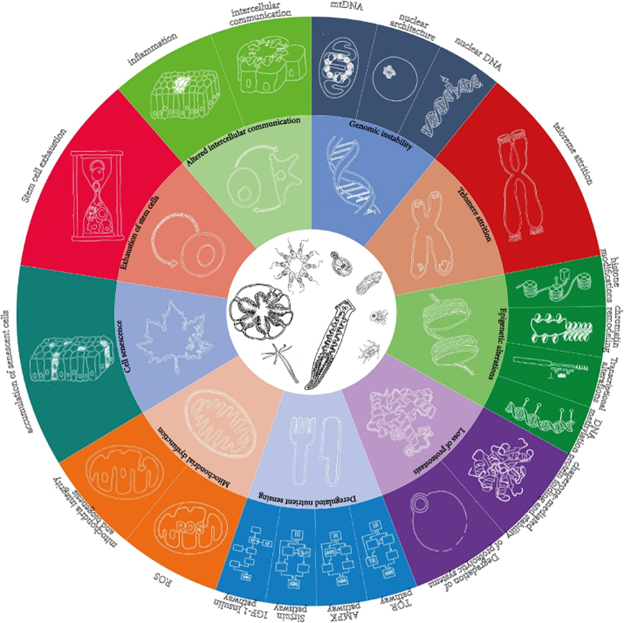
Indeed, everything in this diagram is closely associated with aging. You can start with any item and build an entire theory of aging around it. In fact, this has been done over the years, with a few of the resulting theories useful and some others, like telomere attrition, relativerely useless or plain wrong.. Unfortunately, everything is a close cousin to nothing, and diagrams and explanations like this one that lay out the hallmarks of aging tell us nothing about what the basic and underlying proesses of aging are, and what if anything can be done about them. So we need to take a different tack.
The aging program is very ancient and is “evolutionarily conserved,” which means it responds to a key biological necessity and versions of it are in every living thing. Evolution has passed this program on to new species as they evolved. In creating any new species, evolution usually passes on solutions found workable in the precedent creatures, rather than invent them anew. That is why we have variants of the same organs found in tiny field mice, whales, skunks and elephants. Species-specific variants of this aging program operate in essentially all known species, be they bacteria, insects, plants, fungi, mammals. Every species has its own nominal “use by” expiration maximum lifespan. For humans, 123 years; for many mouse species, 20 months; for fruit flies, 10-20 days. The Mayfly has a lifespan of only 24 hours and completes its life cycle, including reproduction, within one day of its birth.
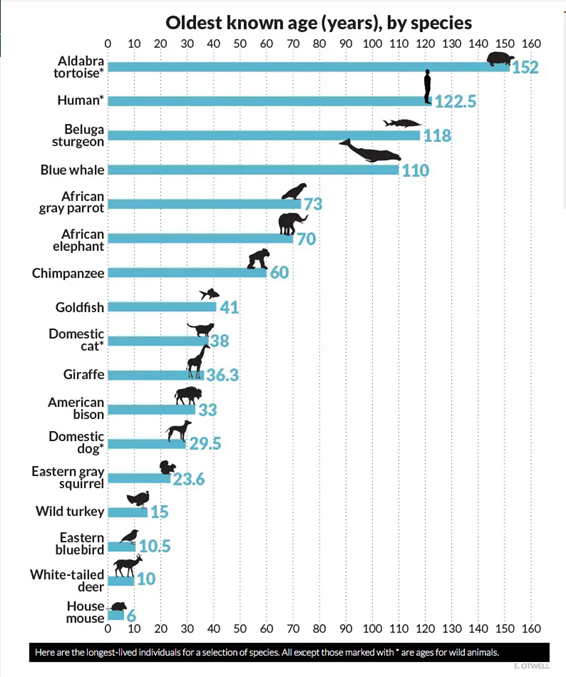
Evolution loves all living entities, and generally seeks to provide for the wellbeing and competitive survival of each. However, evolution loves living species even more. In cases where individual survival and species survival are incompatible, evolution/nature picks the path of species survival. That, I think, is why the final stage of aging is out to kill off every living entity by its species expiration date. That way, younger members of a species don’t have to compete for resources too long with ensconced older members, and even the most horrible and controlling of dictators pass away in time. Aging is how nature implements its drive to best ensure the survival of biological species. Species may survive millions of years, yet lifespans of members of most species are less than our own.
Some current aging science researchers deny that adult aging is programmed. Despite mounting evidence to the contrary, they hold on to the obsolete notion that aging is due to stochastic accumulation of random damage. The first stages of human aging (through initial adulthood) are clearly the results of a complex and exquisitely programmed process. Human embryos and babies almost all end up as viable children. But the older viewpoint that adult aging is caused by accumulated random damage remains popular. If this were so, there would be no species-specific age limits as there are. There would be a tiny few of 200–500-year-old people and a few100 year old dogs. Some of these programmed aging deniers see their prescription for longevity Is something like “If something in your body is broke, fix it.” Great idea. However, that already is the approach of Modern Medicine. See the 2016 article Evolution of Aging Theories: Why Modern Programmed Aging Concepts Are Transforming Medical Research. Further, in this blog we are able to identify the central mechanism of the adult aging program, how it works, and even how to partially hack it.)
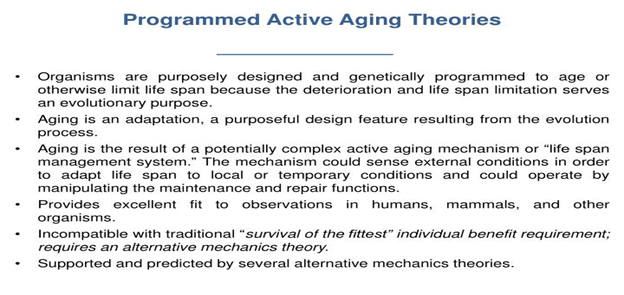
Forget living forever in your present body. Absolutely everything about us as individuals is temporary. I believe we are now in an extremely important decade in the history of biology, however, in which we are now decoding many mysteries of life, learning how to reverse key aspects of aging, and learning how to expand lifespans of healthy individuals, possibly up to hundreds of years. In my research writings and presentations, I have referred to this process as “YOUNGING”. You can find out about much more about it by searching the Internet for this term together with my name. Look for sound podcasts and YouTube videos as well as written treatises.
A few other longevity scientists have also been working on YOUNGING interventions and have demonstrated how their interventions can make old rats younger in most important dimensions. YOUNGING, effective age reversal, has been proven possible!
Aging impacts all levels of every organism known: biochemical, sub-cellular (including mitochondria), cellular, organ, major system and whole organism. Most of the science literature on aging has focused on particular impacts, “Hallmarks of Aging” at particular levels, leaving confusion as to what is secondary vs. what is basic and causal. The fundamental cause of aging is much simpler.
It is a distinct, effective biological program that proceeds in phases, including the program of initial and early development, starting with an egg and a sperm. The essential features of this aging program have become clear to me, but this has only happened recently. This program is out to grow us up successfully until we are 25, + or – a few years, depending on features of the individual. It is working for the good of the species, not the individual. Lifelong until the final phase, it strives to ward off serious infectious diseases and other deadly pathologies. In its final phase, when we get to 80 and beyond, the program it is out to kill everybody.
Throughout most of our lives, the aging program works to keep us healthy. However, if the program can’t manage to do that, it can quickly change its strategy to having your own immune system kill you instead. It does this by loosening a deadly inflammatory cytokine storm. This is to keep people whose condition is too weak to fight off a pathogen from passing that pathogen on to others, accelerating its propagation. It is an example of how evolutionary processes favor survival of a species over survival of an individual when these two objectives are in conflict. This –program is very ancient and versions of it exist in all living species including plants, birds, bees, cows, worms, insects, dolphins, and mushrooms. It is just as efficient and effective as the early development program is. But, being a program, aging can be hacked once one knows exactly how it works. I know of one easy main hack that I think can buy us humans 20-30 or more years of additional healthy active lifespan. It works by slowing the aging program way down. It is available to everybody right now and inexpensive. I know. I am nearly 94, and what I am proposing here has provided me with the wherewithal to lead a full active family and social life, conduct deep research in biomedical literature, attend to Synergy Bioherbals LLC, and generate and publish this blog.
The aging program typically proceeds in stages. The early stages are focused on initial growth and development starting with conception. The finial stage is plain out to kill you one way or the other
THE STAGES OF THE AGING PROGRAM
Let’s look at how aging typically plays out at various stages in the life of a healthy disease-free person in a modern industrialized society, namely at conception and at ages 1, 25, 45, 68, and 85.
Conception
Early development, including embryogenesis, is the first stage of aging and is probably the most complex and remarkable natural process known in all of science. Starting with an ovum and a sperm, it leads to a human body comprising some 37 trillion cells of 200 types, organized to support the complexity of organs and body systems we all have. It is a precisely articulated process involving many stages which have been extensively studied. The fine details of it would fill libraries. All cells in a human body have the same genes. The differences between the some 200 cell types we have are epigenetic, a function of which genes are turned on (expressed; that is, actively make the protein corresponding to that gene) and which are turned off in any particular place in a human body at any given time. This first year of human development is an exquisitely choreographed and very reliable process involving multiple steps of turning dozens, hundreds and thousands of developmental and other genes on and off in an extremely complex and highly specific manner.
How does the developing embryo go about turning a closely related family of genes off and on together to achieve a development step; say, growth and development genes? A big part of the answer is via post-translational modifications of histones, especially methylation/demethylation. Histone methylation/demethylation is a major tool used by the body in early development to turn large and small families of genes on and off together. That is attaching or detaching methyl chemical groups to histones, the “spools” around which DNA is wrapped. For most of the histones, genes in a highly methylated histone spindle are turned off, and cannot be expressed. De-methylating the histone alows the genes to be turned on. For some histones the opposite is so. Many of the genes in our chromosomes are carefully sequenced so this simultaneous turning on and off of highly related genes can happen. Strictly speaking, histone methylation by itself can turn genes off, but promoter site activation is also required to turn them on, Think of histone methylation as a master lock, for example turning all genes associated with histone H3K27 off when double or triple methylation is present. When the methylation is not present, those genes can be turned on individually by promoter site activation.
Each human cell contains about 30 million nucleosomes, and there an octamere of 8 histones per nucleosome. A given histone like H3K27 is therefore repeated thousands of times on each chromosome – meaning that thousands or tens of thousands of genes can be turned off or potentially on by emethylating/methylating that histone.
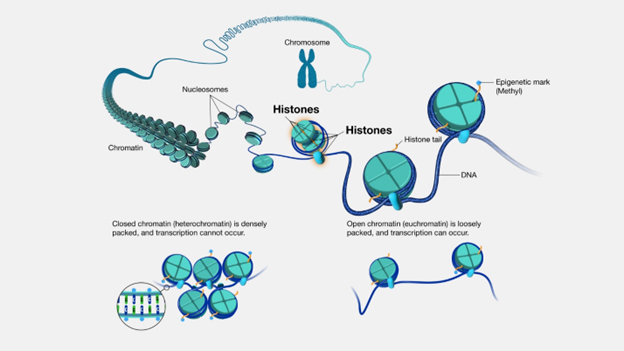
DNA, cellular and other forms of biological damage can and do occur from the earliest moments of life, long before birth and throughout the entire trajectory of a lifetime. These include DNA breaks, misfolded proteins, runaway transposons, aneuploidy, and damaged genes. Such damage is largely unavoidable, inherent in the processes of cell reproduction and life itself; some of it results from environmental toxins or radiation. Fortunately, evolution has endowed our bodies with layers of exquisite mechanisms for detecting serious damage and repairing it. Examples are the mechanisms for repairing single-strand (ref) and double-strand DNA breaks (ref). These maintenance, renewal and repair mechanisms tend to work very well early in life, but become less and less effective as adult aging progresses.
Histone methylation/demethylation plays a central role in DNA repair, although the actual process is incredibly complex. (For a deep dive into this topic you could study the 2021 article The Role of Histone Lysine Methylation in the Response of Mammalian Cells to Ionizing Radiation. Look at the diagrams. As you can see, multiple histones and multiple histone methylases/demethylases are involved. I will continue to focus here on the histone H2k27 and on its demethylases JDJM3 and UTX. I have also not discussed other post-translational histone modifications here, such as acetylation. This discussion, while far from the complete picture, is accurate and sufficient to explain the basics of aging, what it consists of and how it happens).
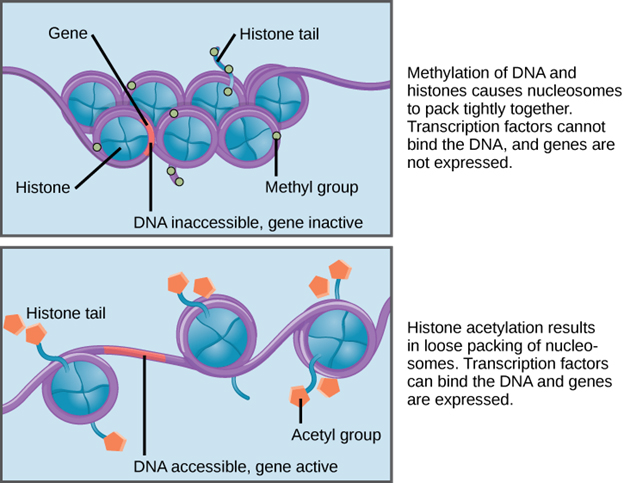
As it happens, many maintenance, repair, and renewal genes are associated with the histone H3K27. Included, for example are the genes for stem-cell differentiation necessary for organ renewal, In the earliest stages of life, the demethylases JDJM3 and UTX are very active at this position and such genes are usuallyactive. To telegraph where I am going here, the same basic mechanisms of istone methylation and demethylation for turning off or turning on hundreds or thousands of genes at once are used in all stages of the aging program throughout life. There is also a complex end-of-life phase of the aging program that kills everybody by age 123, and that phase of the aging program also uses histone methylation to turn groups of genes off and on.
An additional level of body flexibility as well as intellectual complexity is added by the fact that H3K27me3 along with H3K4me3 are part of a bivalent domain, which means the body can easily and quickly switch between inactivating histone-associated genes-( H3K27me3) and activating them (H3K4me3).
AGE 1
The initial Developmental Phase of the program has been at it 21 months, during the pregnancy period and for a year after birth, It has accomplished much but still has a very long way to go. Again, our bodies are the most complex structures known to exist in the universe, and this development process is probably the most complex natural process known. Continuing with a simplified but correct description of what is most relevant here: during the early phases of development, there continues to be a high degree of organ-specific expression of JDJM3 and UTX, the demethylases that keeps double and triple methylation from happening during development at histone position H3k27. This is necessary to allow full expression of large numbers of growth and development genes as well as maintenance and repair genes. There are also times and places during early development when these demethylases are turned off. At age1 there is still a lot of growth and development to be done. More detail on the specific importances of JDJM3 and UTX became available some 20 years ago. See the 2007 publication Identification of JmjC domain-containing UTX and JMJD3 as histone H3 lysine 27 demethylases.
AGE 25 (+/- 3- 5 years depending on the individual.)
This is the typical age when the Development phases of the Aging Program give way to the Adult Aging phases in humans. This transition can be noticed in many species, including plants. In some species it can occur very rapidly, taking place in a few hours. In many species, it occurs just after the initial phase of offspring-bearing. The transition involves lowering of expression of JDJM3 and UTX, the demethylases that keeps double and triple methylation from happening during development at histone position H3k27.
In 2014 Morimoto wrote in Proteostasis and longevity: when does aging really begin? “Here, we propose, from studies in Caenorhabditis elegans, that proteostasis collapse is not gradual but rather a sudden and early life event that triggers proteome mismanagement, thereby affecting a multitude of downstream processes. Furthermore, we propose that this phenomenon is not stochastic but is instead a programmed re-modeling of the proteostasis network that may be conserved in other species. As such, we postulate that changes in the proteostasis network may be one of the earliest events dictating healthy aging in metazoans.” In 2020 Morimoto further wrote in Cell-Nonautonomous Regulation of Proteostasis in Aging and Disease: “Additionally, in metazoans, proteome stability and the functional health of proteins is optimized for development and yet declines throughout aging, accelerating the risk for misfolding, aggregation, and cellular dysfunction. Here, I describe the cell-nonautonomous regulation of organismal PN by tissue communication and cell stress-response pathways. These systems are robust from development through reproductive maturity and are genetically programmed to decline abruptly in early adulthood by repression of the heat shock response and other cell-protective stress responses, thus compromising the ability of cells and tissues to properly buffer against the cumulative stress of protein damage during aging.” At the time of transition, the Polychrome Repressive Complex (PRC) starts its adult job of inducing double and triple methylation at H3k27me2-3, slowly at first. This and methylation changes at other histone positions have net impact of starting to down-regulate numerous repair, maintenance and renewal genes. Yet at this age the expression of these genes is still near maximal. There is little to no tissue damage or consequent inflammation. As we know, many people at this age are very healthy and think and often behave as if that situation will go on forever. Diseases are generally rare and tend to resolve quickly.
Several aspects of human behavior seem to be affected by this transition One thing is discussed in the 2017 publication Human behavioral complexity peaks at age 25. “Our main finding is that the developmental curve of the estimated algorithmic complexity of responses is similar to what may be expected of a measure of higher cognitive abilities, with a performance peak around 25 and a decline starting around 60.”
This phenomenon, involving histone changes marking the transition from growth and development, applies to most forms of life, including plants. For example, see Cell-type-dependent histone demethylase specificity promotes meiotic chromosome condensation in Arabidopsis
AGE 45.
The PRC has been doing its methylation job for 20 years now, and many key repair, renewal and maintenance genes associated with H3K27 are significantly downregulated. With the downregulation of these genes and the tasks they perform, some tissues begin to be distressed, become inflamed and start emitting inflammatory cytokines like TNF-alpha, IL-1, IL-6 and IL-22. Systematic inflammation is more manifest. Diseases and sicknesses and signs of aging of all kinds are becoming more common and of concern, including arthritis, bronchitis, pneumonia, near-sightedness, obesity, asthma, diabetes, genitourinary disorders, hypertension, mental disorders, and strokes.
Yet, despite partial methylation, body repair, maintenance and renewal genes are still generally active enough to support largely good functioning. Medications and leading a healthy lifestyle may be helpful in postponing serious disease consequences. Hallmarks of aging are evident, and the person looks like a 45-year-old, no longer like he/she looked at 25.
YES, AGING IS NOT DUE TO ACCUMULATION IF RANDOM DAMAGE. IT IS DUE TO PROGRESSIVE DOWNGRADING OF NATURAL DAMAGE REPAIR AND RENEWAL PROCESSES ASSOCIATED WITH PROGRESSIVE DOWN-REGULATION OF KEY MAINTENANCE AND RENEWAL GENES.
AGE 68.
The Adult Aging Program has been at work some 43 years now. DNA histone methylation is now such that body repair, maintenance and renewal genes are functioning at a fraction of their original levels. They are too methylated. And some developmental genes that produce unwanted actions for aging adults are being progressively turned back on. Multiple tissue types and organs are experiencing increasing distress, and are emitting copious levels of inflammatory cytokines, which persist in the bloodstream. These increase methylation levels of protective genes even further, in a positive feedback loop. The overall body is going into a hyper inflammatory state. And incidences of the inflammatory diseases the kill old people are becoming frequent: cancers of all types, retinopathy, inflammatory lung diseases, dementias, coronary artery and valve diseases, auto-immune diseases like arthritis, lupus and scleroderma, gout, etc.; the “usual suspects” for killing old people. Several such diseases can occur at the same time. People at this age are more prone to catching infectious diseases like SARS or COVIDs, and use of the health care system is typically accelerating. Heart attacks and strokes are becoming common. Many friends in the same age cohort are moving into Assisted Living; some are going into nursing homes. Emergency Room visits are becoming more commonplace. Some family members and dear friends are starting to die.
AGE 85.
The situation described for age 68 has become much more dire in every respect. Histone and DNA methylation are at levels where many repair, maintenance and renewal genes are close to being completely silenced. DNA methylation and circulatory inflammatory cytokine levels seem hopelessly abnormal. A positive feedback loop of whole-body hyper inflammation leading to ever more unwanted DNA histone methylation has taken over. Tissue and organ damage are extensive, and the diseases of old age are rampant and doing their pre-killer and killer jobs. Far less than 30% of the population makes it to this age. And if you do manage to live that long, your general outlook is not good. From this age onward, you are likely to experience increasing frailty and multiple emergency room visits and hospitalizations. You might pass the final months or years of your life in a nursing home with dementia, a semi-functioning heart, and an incurable cancer. Aging can (and does) kill you in thousands of different ways. Organ and system failures and diseases are among the most common. There are more than 100 types of cancer that can affect almost every part of the body. 100% of the time, “All the King’s Horses and All the King’s Men,” of medicine and health care can’t rescue you from the final Death Phase of the Adult Aging Program. A version of the Adult Aging Program works for every advanced species we know of. Everything alive dies, no exceptions.
Let me contrast my personal situation at near-94 with the grim scenario for 85 year olds listed above. I have none of the known degenerative diseases of advanced aging. I haven’t seen a real doctor for 10 months. Last time I was hospitalized (for 1 day) was nearly a year ago and that was because of broken ribs due to a freak accident. I can walk for miles, mow my acre of lawn, chase my little granddaughters and grandsons around the back yard, climb a stepladder, cook up pasta Bolognese for the whole family, vacuum key areas of the house, do the laundry and wash a sink-full of dishes and load the dishwasher every night. And get in 6-12 hours of longevity research, communications with colleagues and writing every day. Unlike some of my close colleagues, I only monitor a tiny collection of health and aging biomarkers. For the same reason most people in their 30s and 40’s don’t bother with their biomarkers – they don’t have to.
I do not claim to have defeated aging. But there is both scientific and personal evidence that it can drastically be slowed down. And some small-animal evidence from researchers like the Conboys and Harold Katcher.
HACKING THE AGING PROGRAM
Being a program that we can understand, aging is at least partially amenable to hacking. I believe I have just described the central causal chain of events involved in human aging. And those events allow us to identify with confidence how to slow advanced aging. The aging program can be hacked, basically by blocking the hyper-inflammation part of the positive feedback loop in the final phase. I have been pursuing various approaches to controlling inflammation for over 30 years now, and you can read some key blog posts I have written on the science of inflammation My primary intervention for blocking systemic inflammation in the last ten years has been regularly taking 4 Herb Synergy (4HS) – a nano-preparation of certain herbal anti-inflammatory dietary supplements. As below, I also do a lot of other things to lower systemic inflammation. I am sure some of these are important, but I don’t know how important. What I can say is that if I discontinue taking 4HS, in 3-4 weeks I start getting distressing inflammatory symptoms which get worse and worse. Resuming 4HS, these symptoms vanish in a week or so. Discontinuing other anti-inflammatory supplements or activities for up to 1-2 months while still staying on 4HS, I have not noticed any strong negative effects.
Other researcher Findings
A few other researchers have suggested other strategies, all of which have the impact of blocking chronic inflammation. Irina and Michael Conboy, prominent aging researchers, have suggested periodic purifying of circulating blood from the pro-inflammatory cytokines using an apheresis machine(ref). Apheresis involves the removal of blood plasma from the body by the withdrawal of blood, its separation into plasma and cells, purification of the plasma, and the reintroduction of the cells and purified plasma into the body. Their small-animal experiments suggest that that process also works for the reduction of circulating inflammatory cytokines. Their aged small animals by multiple measures get younger. While it works, apheresis is not practical for most people. because it is expensive, invasive, requires technical expertise and the use of a special machine. Further, for apheresis it to be effective in keeping the bloodstream free of inflammatory cytokines, the process must be repeated every 3 weeks or so.
Approaches to YOUNGING used by other researchers include injections of exosomes derived from young pig blood plasma (ref: Reversal of Biological Age in Multiple Rat Organs by Young Porcine Plasma Fraction), and treatment with GDF11, often a strongly anti-inflammatory blood factor(ref)(ref). I will not discuss these further here since they cannot be practically pursued by ordinary people. What is important is that there are multiple purportedly positive approaches to longevity being pursued by several research group. A few of these have demonstrated mild longevity impacts on small animals. Other than what is being reported here, there has been no recent empirical research related to human longevity. For some time, it has neen known that mild human longevity increases have been shown to result from calorie restriction regimens, taking rapamycin and taking metformin..
Other strategies I have been using to combat systemic inflammation
I list the most important of the additional anti-inflammatory strategies I have been pursuing here. I have discussed each of these in detail in articles in my longevity blog, agingsciences.com.
- Taking additional anti-inflammatory additional supplements in pill/capsule form, such as NRF2 activators like gingko biloba, milk thistle extract, saw palmetto, and bacopa, (ref)(ref)(ref)
- Taking a quality fish oil supplement, one that is high in DHA and EPA. These oils contain key substances important for the resolution phase of acute inflammation to occur, the normally final stage where the inflammation vanishes. The substances are called resolvins, protectins, maresins and lipoxins(ref),
- Taking supplements like nicotinamide riboside to upgrade the expression of the NAD+ metabolic factor, upregulating a number of protective genes(ref),
- Taking supplements intended to improve mitochondrial electron transfer chain functioning (ref)
- Synchronizing to critical brainwave frequency Via Pulsed Electromagnetic Frequency (PEMF) devices, which helps me concentrated better during days and sleep better at night(ref),
- Photobiomodulaltion, including selective partial body irradiation with critical infrared frequencies(ref),
- Pursuit of a number of simple daily hormesis techniques, Including deliberate exposure to whole-body heat conditions (EG, sauna) and cold exposures, to upregulate expression of heat shock and cold shock proteins(ref),
- Exercising while breathing oxygen, a process known as EWOT(ref),
- Living and interacting constantly with significantly younger wives and family members(ref), and
- Getting ample solid REM and Deep sleep on a regular schedule(ref).
These are all interventions that I have researched and know are powerfully anti-inflammatory.
Acute vs Chronic Inflammation
The inflammatory process is an essential first-line immunologic defense system evolved in advanced organisms to confer protection required for survival of individuals. Short-term acute inflammation is part of wound healing and acts against harmful agents, such as pathogens, toxins, or allergens. Familiar manifestations of it are the itchy red bumps of mosquito bites, fever when you have the flu, and redness and swelling associated with burns. Less familiar ones can include muscle weakness, diarrhea, nausea, joint pain, and skin rashes. Normal inflammation involves a number of distinct phases, including a final resolution phase.
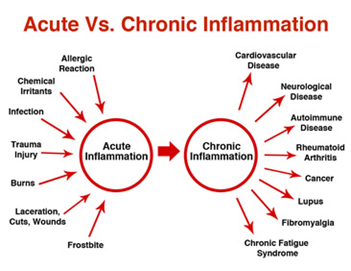 Image source “Under normal conditions, the tightly coordinated actions of various defense components including immune cells, endogenous anti-inflammatory agents, and tissue remodeling processes enable the resolution of acute inflammation by facilitating the elimination of pathogens, infected cells, and repair to damaged tissues to restore body homeostasis [1]. However, when this intricate acute inflammatory response fails to resolve and instead persists, more defense components are mobilized to create a long-term unresolved immune response known as chronic inflammation. Chronic inflammation, which typically manifests itself in a low-grade manner for a prolonged period, involves macrophage- and lymphocyte-accumulated leukocytes [2], and various other cellular components. It is important to recognize that this chronic inflammation is causally associated with changes in the cellular redox state and cell death signaling pathways.” So, Chronic inflammation is inflammation that does not resolve. In this discussion of longevity, by “systemic inflammation,” I am referring to chronic whole-body inflammation. This discussion highlights how systematic inflammation is both caused by and causal of epigenetic aging. Some drugs (like prednisone) tend to block both types of inflammation. They can be used only for short periods because acute inflammation is an important tool of natural body protection. 4HS blocks chronic inflammation while still allowing acute inflammation. As a long-term user of 4HS, I have an intact and strong wound healing capability, meaning I can respond with acute inflammation when needed, while controlling my systemic inflammation.
Image source “Under normal conditions, the tightly coordinated actions of various defense components including immune cells, endogenous anti-inflammatory agents, and tissue remodeling processes enable the resolution of acute inflammation by facilitating the elimination of pathogens, infected cells, and repair to damaged tissues to restore body homeostasis [1]. However, when this intricate acute inflammatory response fails to resolve and instead persists, more defense components are mobilized to create a long-term unresolved immune response known as chronic inflammation. Chronic inflammation, which typically manifests itself in a low-grade manner for a prolonged period, involves macrophage- and lymphocyte-accumulated leukocytes [2], and various other cellular components. It is important to recognize that this chronic inflammation is causally associated with changes in the cellular redox state and cell death signaling pathways.” So, Chronic inflammation is inflammation that does not resolve. In this discussion of longevity, by “systemic inflammation,” I am referring to chronic whole-body inflammation. This discussion highlights how systematic inflammation is both caused by and causal of epigenetic aging. Some drugs (like prednisone) tend to block both types of inflammation. They can be used only for short periods because acute inflammation is an important tool of natural body protection. 4HS blocks chronic inflammation while still allowing acute inflammation. As a long-term user of 4HS, I have an intact and strong wound healing capability, meaning I can respond with acute inflammation when needed, while controlling my systemic inflammation.
ANSWER TO A KEY QUESTION
The new perspective of this article answers a central question I have been asking myself for years. That is: Which of the longevity interventions that I have been pursuing in recent years have been efficacious in allowing me to be essentially disease free, cognitively sharp and still highly productive as I grow older, now approaching age 94? Which one or ones are central? The answer is the interventions that combat systemic inflammation, in my case the main approach having been regular taking of 4 Herb Synergy during the last seven years, and for the twenty years before that, taking the 4HS herbal anti-inflammatory components. And this was done with a different intent than longevity in mind.


Vince
As always you are the smartest of the smart.
Thank you
This is the best blog post bringing a world of anti-aging research into a concise format.
What are your thoughts on the frequent immunizations that we are being asked to undergo ie yearly flu, covid , and now RSV. All create an inflammatory response which of course is important for limiting (not usually blocking getting the virus) but limiting the severity of the illness. Nevertheless, we are stimulating the acute inflammatory response, now on a frequent almost continuous basis….chronic inflammation! At some point in terms of aging shouldn’t we cut back?
My suggestion would be to avoid contact ie avoiding crowds and proper masking
and consider cutting back on “boosters”
ps your 4HS has been working for me. Thank you !